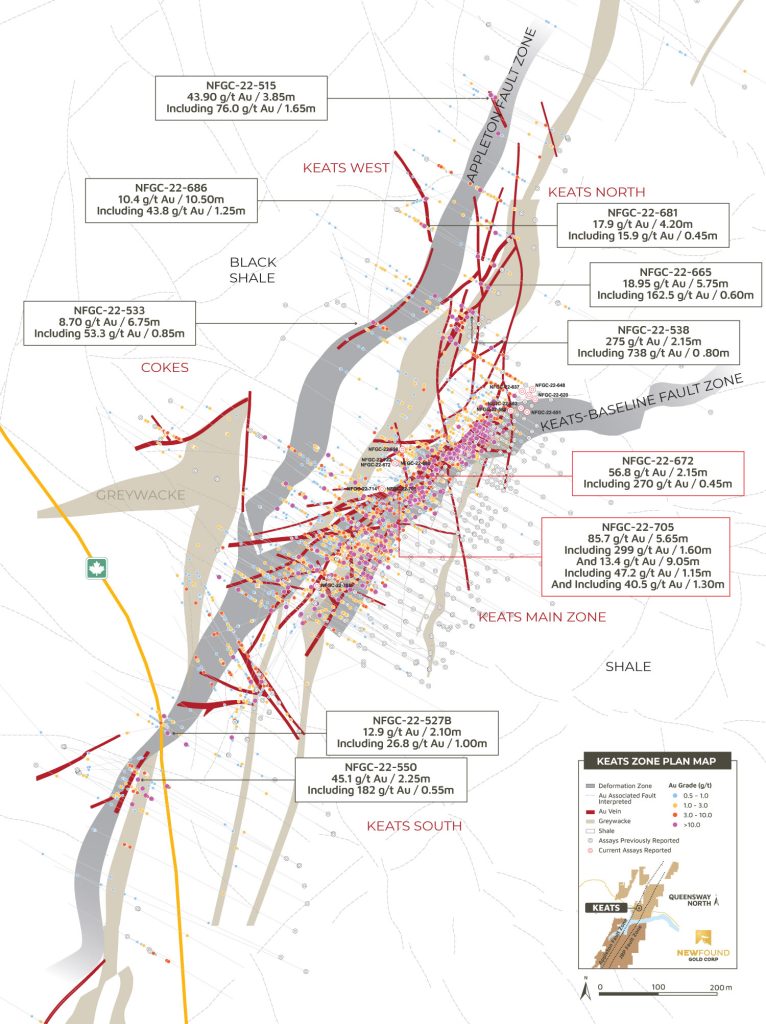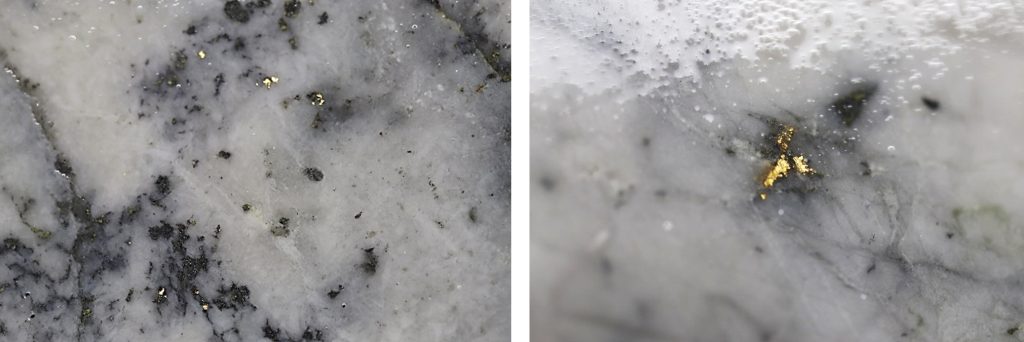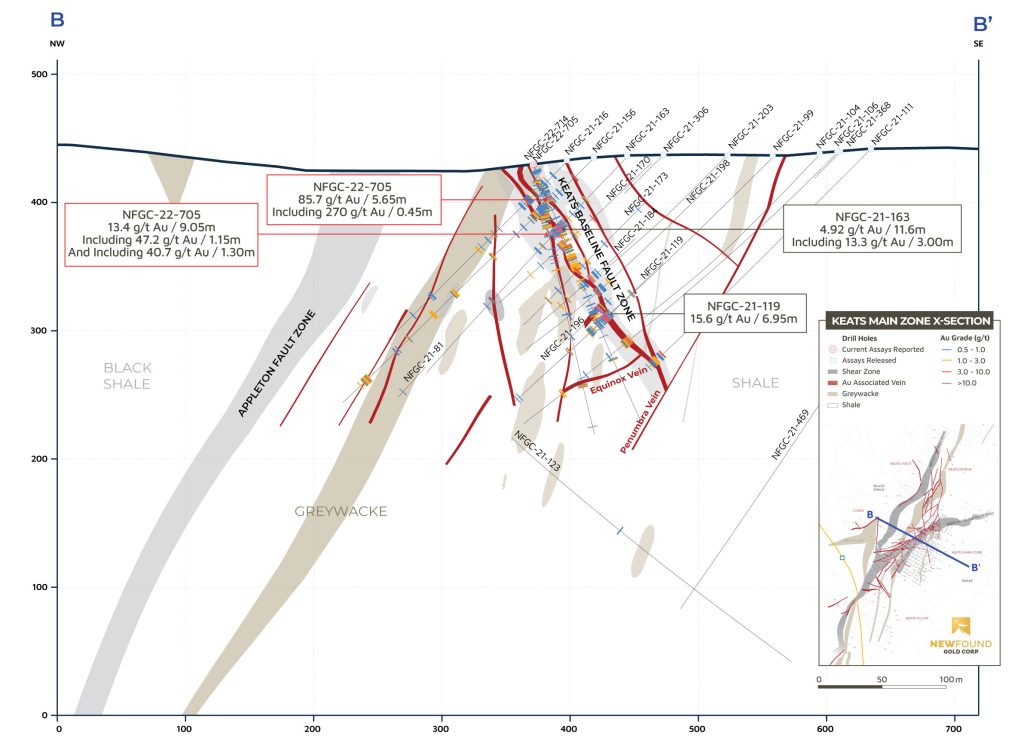
New Found Intercepts 85.7 G/T AU Over 5.65M & 13.4 G/T AU Over 9.05M at Keats Main Zone, Initiates Use of Chrysos PhotonAssayTM Method

New Found Gold Corp. (TSX-V: NFG) (NYSE-A: NFGC) is pleased to announce the results of its Chrysos PhotonAssayTM method test program in addition to assay results from 14 diamond drill holes completed as part of a program designed to test the Keats Main Zone located along the highly prospective Appleton Fault Zone. New Found’s 100%-owned Queensway project comprises a 1,650km2 area, accessible via the Trans-Canada Highway, 15km west of Gander, Newfoundland and Labrador.
Keats Drilling Highlights:
- The Company is pleased to report high-grade intervals of 85.7 g/t Au over 5.65m and 13.4 g/t Au over 9.05m in NFGC-22-705 and 56.8 g/t Au over 2.15m in NFGC-22-672 from drilling at the Keats Main Zone that was designed to expand on mineralization hosted within the Keats-Baseline Fault Zone and to target specific high-grade gold vein orientations and vein intersections not previously well-tested. These holes were drilled at a low angle to the KBFZ to target the less well-constrained vein orientations and to identify new veins hosted within it (Figures 1, 2 and 3).
| Hole No. | From (m) | To (m) | Interval (m)1 | Au (g/t) | Zone |
| NFGC-22-672 | 54.65 | 56.80 | 2.15 | 56.83 | Keats Main |
| Including | 55.10 | 55.55 | 0.45 | 270.00 | |
| NFGC-22-705 | 26.40 | 32.05 | 5.65 | 85.67 | Keats Main |
| Including | 28.90 | 30.50 | 1.60 | 298.93 | |
| And | 51.50 | 60.55 | 9.05 | 13.42 | |
| Including | 52.05 | 53.20 | 1.15 | 47.19 | |
| And Including | 54.80 | 56.10 | 1.30 | 40.74 | |
| Table 1: Keats Drilling Highlights | |||||
| 1Note that the host structures are interpreted to be steeply dipping and true widths are generally estimated to be 10% to 70% of reported intervals. Infill veining
in secondary structures with multiple orientations crosscutting the primary host structures are commonly observed in drill core which could result in additional uncertainty in true width. Composite intervals reported carry a minimum weighted average of 1 g/t Au diluted over a minimum core length of 2m with a maximum of 2m consecutive dilution. Included high-grade intercepts are reported as any consecutive interval with grades greater than 10 g/t Au. Grades have not been capped in the averaging and intervals are reported as drill thickness. |
|||||
Chrysos PhotonAssayTM Highlights:
- Following detailed testwork and a quality control program, the Company and its consultants have found the Chrysos PhotonAssayTM method to be an appropriate technique for determining gold content in Queensway Project samples. Over the past several months, the Company tested hundreds of samples in the low, mid, and high-grade range, comparing the results of the photon assay method to traditional fire assay, and found a very strong correspondence of the results.
- Moving forward, the Company will use the photon assay method at MSALABS’ Val-d’Or facility as well as ALS Minerals’ Vancouver laboratory for traditional fire assay and screen fire determination, to ensure the most efficient turnaround times on assays. The ongoing quality control program will include analysis of some samples by both methods to monitor accuracy.
- Mineralization reported today provided the photon assay test program with the ultra-high-grade (+100 g/t) gold material that is often found in the Keats Main Zone and provided an important component of the QAQC test work program.
Melissa Render, VP Exploration for New Found stated: “Today’s results are impressive and continue to outline high-grade gold mineralization that can be found in multiple orientations at Keats. We are also excited to debut the use of the Chrysos PhotonAssayTM method following several months of testwork, clearing the way for New Found to begin shipping a steady flow of material to MSALABS for assaying. The photon assay method is efficient, non-destructive, cost effective, and environmentally friendly. These are important attributes that we strive to incorporate into all aspects of exploration at New Found Gold and we are excited to partner with Chrysos and MSALABS to apply this technology at Queensway.”
“Prior to releasing photon assay results, New Found conducted a thorough evaluation of the method by doing extensive testing against fire assay determinations. Even though over 3 million photon assays have been reported worldwide to date, it was important to prove to management that the method does not bias gold results with respect to fire assay for Queensway samples,” reports Lynda Bloom, a sampling and assay expert that has assisted New Found with its QC programs and who has evaluated photon assay data for several other projects.
Drillhole Details
| Hole No. | From (m) | To (m) | Interval (m)1 | Au (g/t) | Zone | |||||||
| NFGC-22-551 | 42.55 | 45.50 | 2.95 | 1.88 | Keats Main | |||||||
| Including | 45.20 | 45.50 | 0.30 | 10.61 | ||||||||
| And | 50.00 | 52.00 | 2.00 | 1.14 | ||||||||
| And | 77.50 | 83.40 | 5.90 | 5.07 | ||||||||
| Including | 77.50 | 78.05 | 0.55 | 12.52 | ||||||||
| Including | 80.20 | 80.70 | 0.50 | 10.99 | ||||||||
| Including | 81.80 | 82.40 | 0.60 | 16.86 | ||||||||
| And | 129.10 | 131.45 | 2.35 | 2.29 | ||||||||
| Including | 129.65 | 130.15 | 0.50 | 10.19 | ||||||||
| NFGC-22-562 | 54.20 | 59.85 | 5.65 | 2.05 | Keats Main | |||||||
| And | 74.50 | 76.50 | 2.00 | 8.35 | ||||||||
| Including | 75.50 | 76.50 | 1.00 | 16.63 | ||||||||
| And | 94.40 | 96.40 | 2.00 | 1.05 | ||||||||
| NFGC-22-589 | 25.10 | 27.40 | 2.30 | 1.87 | Keats Main | |||||||
| NFGC-22-620 | 108.00 | 111.00 | 3.00 | 2.32 | Keats Main | |||||||
| NFGC-22-624 | 40.60 | 43.00 | 2.40 | 1.02 | Keats Main | |||||||
| And | 76.00 | 78.00 | 2.00 | 2.14 | ||||||||
| And | 93.00 | 95.20 | 2.20 | 1.13 | ||||||||
| NFGC-22-637 | 22.00 | 24.45 | 2.45 | 2.12 | Keats Main | |||||||
| And | 26.00 | 28.00 | 2.00 | 1.22 | ||||||||
| And | 44.00 | 47.40 | 3.40 | 1.69 | ||||||||
| NFGC-22-648 | 70.60 | 72.90 | 2.30 | 1.53 | Keats Main | |||||||
| NFGC-22-672 | 54.65 | 56.80 | 2.15 | 56.83 | Keats Main | |||||||
| Including | 55.10 | 55.55 | 0.45 | 270.00 | ||||||||
| And | 88.65 | 91.55 | 2.90 | 4.87 | ||||||||
| Including | 88.65 | 89.00 | 0.35 | 38.60 | ||||||||
| NFGC-22-680 | 104.00 | 109.30 | 5.30 | 1.55 | Keats Main | |||||||
| And | 124.05 | 127.50 | 3.45 | 2.37 | ||||||||
| And | 150.10 | 153.00 | 2.90 | 1.47 | ||||||||
| NFGC-22-698 | 10.20 | 12.85 | 2.65 | 3.54 | Keats Main | |||||||
| And | 73.45 | 75.75 | 2.30 | 1.02 | ||||||||
| NFGC-22-705 | 26.40 | 32.05 | 5.65 | 85.67 | Keats Main | |||||||
| Including | 28.90 | 30.50 | 1.60 | 298.93 | ||||||||
| And | 51.50 | 60.55 | 9.05 | 13.42 | ||||||||
| Including | 52.05 | 53.20 | 1.15 | 47.19 | ||||||||
| Including | 54.80 | 56.10 | 1.30 | 40.74 | ||||||||
| And | 63.00 | 65.45 | 2.45 | 5.79 | ||||||||
| Including | 65.00 | 65.45 | 0.45 | 25.17 | ||||||||
| And | 68.00 | 80.00 | 12.00 | 1.51 | ||||||||
| And | 83.80 | 90.00 | 6.20 | 2.17 | ||||||||
| And | 126.80 | 131.00 | 4.20 | 1.48 | ||||||||
| And | 163.30 | 165.40 | 2.10 | 1.10 | ||||||||
| NFGC-22-714 | 12.90 | 15.00 | 2.10 | 1.39 | Keats Main | |||||||
| And | 36.60 | 45.30 | 8.70 | 1.39 | ||||||||
| And | 48.65 | 51.00 | 2.35 | 1.85 | ||||||||
| And | 55.80 | 58.00 | 2.20 | 2.95 | ||||||||
| Including | 55.80 | 56.30 | 0.50 | 10.35 | ||||||||
| And | 73.90 | 76.00 | 2.10 | 1.21 | ||||||||
| And | 176.15 | 178.60 | 2.45 | 3.49 | ||||||||
| Including | 178.00 | 178.30 | 0.30 | 13.60 | ||||||||
| NFGC-22-722 | 29.90 | 32.25 | 2.35 | 1.01 | Keats Main | |||||||
| NFGC-22-785 | 8.55 | 13.00 | 4.45 | 1.35 | Keats Main | |||||||
| And | 52.75 | 56.05 | 3.30 | 1.37 | ||||||||
| And | 62.80 | 64.90 | 2.10 | 1.01 | ||||||||
| Table 2: Summary of composite results reported in this press release for Keats | ||||||||||||
| 1Note that the host structures are interpreted to be steeply dipping and true widths are generally estimated to be 10% to 70% of reported intervals. Infill veining
in secondary structures with multiple orientations crosscutting the primary host structures are commonly observed in drill core which could result in additional uncertainty in true width. Composite intervals reported carry a minimum weighted average of 1 g/t Au diluted over a minimum core length of 2m with a maximum of 2m consecutive dilution. Included high-grade intercepts are reported as any consecutive interval with grades greater than 10 g/t Au. Grades have not been capped in the averaging and intervals are reported as drill thickness.
|
||||||||||||
| Hole No. | Azimuth (°) | Dip (°) | Length (m) | UTM E | UTM N | |||||||
| NFGC-22-551 | 300 | -45 | 284 | 658274 | 5427561 | |||||||
| NFGC-22-562 | 299 | -45.5 | 141 | 658264 | 5427567 | |||||||
| NFGC-22-589 | 300 | -45 | 129 | 658247 | 5427562 | |||||||
| NFGC-22-620 | 300 | -45 | 123 | 658289 | 5427581 | |||||||
| NFGC-22-624 | 300 | -45 | 111 | 658278 | 5427588 | |||||||
| NFGC-22-637 | 300 | -45 | 93 | 658267 | 5427595 | |||||||
| NFGC-22-648 | 300 | -45 | 141 | 658284 | 5427598 | |||||||
| NFGC-22-672 | 133 | -70 | 213 | 658052 | 5427473 | |||||||
| NFGC-22-680 | 127 | -60 | 231 | 658052 | 5427474 | |||||||
| NFGC-22-698 | 134 | -67 | 231 | 658063 | 5427496 | |||||||
| NFGC-22-705 | 131 | -68 | 219 | 658028 | 5427429 | |||||||
| NFGC-22-722 | 24 | -69 | 99 | 658052 | 5427474 | |||||||
| NFGC-22-714 | 138 | -77 | 216 | 658028 | 5427429 | |||||||
| NFGC-22-785 | 300 | -45 | 273 | 657918 | 5427265 | |||||||
| Table 3: Details of drill holes reported in this press release | ||||||||||||
Discussion
- The Chrysos PhotonAssayTM method has been in development for nearly 15 years and was originally developed at Australia’s national science agency, CSIRO.
- The Chrysos PhotonAssayTM method uses high-energy X-rays to excite atomic nuclei which emanate a unique signature that can be measured allowing the rapid analysis of gold in approximately two minutes. Further information regarding the photon assay method can be found on the following website: https://chrysoscorp.com/photonassay/.
- Chrysos PhotonAssayTM machines have been commissioned by some of the largest commercial assay laboratories including Intertek’s laboratory facility in Perth, Australia. The method has been used by a broad spectrum of gold mining and exploration companies for over five years, primarily in Australia, for mine control to disclosure of resource estimates. Kirkland Lake Gold (now Agnico Eagle) has a unit installed at its Fosterville Mine in Victoria, Australia, and Barrick Gold with MSALABS’ operates a unit at its Bulyanhulu mine in Tanzania.
- The benefits of utilizing the Chrysos PhotonAssayTM method include a more cost-effective analysis of larger samples that are nearly 15 times the size of a standard 30-g fire assay and better turnaround times. It is non-destructive which allows the same material to be re-assayed by other methods for gold or other testwork. It is an environmentally friendly alternative to traditional fire assay methods that utilize lead in the process.
- The test program included a total of 651 approximately 450-g samples that were initially analysed using the Chrysos PhotonAssayTM method at MSALABS in Val-d’Or and then subsequently shipped to ALS Minerals in Vancouver for follow-on screen metallic fire assay or standard fire assay method for comparison. The results from the test program demonstrate that the two methods agree well, and the Company and its consultants concluded that the photon assay method is appropriate for Queensway samples.
Queensway 400,000m Drill Program Update
Approximately 76% of the planned 400,000m program at Queensway has been drilled to date with approximately 65,635m of the core still pending assay results.
Sampling, Sub-sampling, and Laboratory
True widths of the intercepts reported in this press release have yet to be determined but are estimated to be 10% to 70% of reported core lengths. Infill veining in secondary structures with multiple orientations crosscutting the primary host structures are commonly observed in drill core which could result in additional variability in true width. Assays are uncut, and composite intervals are calculated using a minimum weighted average of 1 g/t Au diluted over a minimum core length of 2m with a maximum of 2m consecutive dilution. Included high-grade intercepts are reported as any consecutive interval with grades greater than 10 g/t Au.
All drilling recovers HQ core. Drill core is split in half using a diamond saw or a hydraulic splitter for rare intersections with incompetent core.
A geologist examines the drill core and marks out the intervals to be sampled and the cutting line. Sample lengths are mostly 1.0 meter and adjusted to respect lithological and/or mineralogical contacts and isolate narrow (<1.0m) veins or other structures that may yield higher grades.
Technicians saw the core along the defined cutting line. One-half of the core is kept as a witness sample and the other half is submitted for analysis. Individual sample bags are sealed and placed into totes, sealed and marked with the contents.
NFG submits samples for gold determination by fire assay to ALS Canada Ltd. and by photon assay to MSALABS since June 2022. ALS and MSA operate under a commercial contract with New Found.
Drill core samples are shipped to ALS for sample preparation in Sudbury, Ontario, Thunder Bay, Ontario, or Moncton, New Brunswick. ALS is an ISO-17025 accredited laboratory for the fire assay method.
Drill core samples are also submitted to MSA in Val-d’Or, Quebec. MSA operates numerous laboratories worldwide and maintains ISO-17025 accreditation for many metal determination methods. Accreditation of the photon assay method at the MSA Val D’Or laboratory is in progress.
At ALS, the entire sample is crushed to approximately 70% passing 2mm. A 3,000-g split is pulverized. “Routine” samples do not have visible gold (VG) identified and are not within a mineralized zone. Routine samples are assayed for gold by 30-g fire assay with an inductively-couple plasma spectrometry (ICP) finish. If the initial 30-g fire assay gold result is over 1 g/t, the remainder of the 3,000-g split is screened at 106 microns for screened metallics assay. For the screened metallics assay, the entire coarse fraction (sized greater than 106 microns) is fire assayed and two splits of the fine fraction (sized less than 106 microns) are fire assayed. The three assays are combined on a weight-averaged basis. Samples that have VG identified or fall within a mineralized interval are automatically submitted for screened metallic assay for gold.
At MSA, the entire sample is crushed to approximately 70% passing 2mm. For “routine” samples that do not have VG identified and are not within a mineralized zone, the samples are riffle split to fill two 450g jars for photon assay. The assays reported from both jars are combined on a weight-averaged basis. If one of the jars assays greater than 1 g/t, the remaining crushed material is weighed into multiple jars and are submitted for photon assay.
For samples that have VG identified or are within a mineralized zone, the entire crushed sample is weighed into multiple jars and are submitted for photon assay. The assays from all jars are combined on a weight-averaged basis.
All samples prepared at ALS or MSA are also analyzed for a multi-element ICP package (ALS method code ME-ICP61) at ALS Vancouver.
Drill program design, Quality Assurance/Quality Control and interpretation of results are performed by qualified persons employing a rigorous Quality Assurance/Quality Control program consistent with industry best practices. Standards and blanks account for a minimum of 10% of the samples in addition to the laboratory’s internal quality assurance programs.
Quality Control data are evaluated on receipt from the laboratories for failures. Appropriate action is taken if assay results for standards and blanks fall outside allowed tolerances. All results stated have passed New Found’s quality control protocols.
New Found’s quality control program also includes submission of the second half of the core for approximately 5% of the drilled intervals. In addition, approximately 1% of sample pulps for mineralized samples are submitted for re-analysis to a second ISO-accredited laboratory for check assays.
The Company does not recognize any factors of drilling, sampling or recovery that could materially affect the accuracy or reliability of the assay data disclosed.
The assay data disclosed in this news release have been verified by the Company’s Qualified Person against the original assay certificates.
The Company notes that it has not completed any economic evaluations of its Queensway Project and that the Queensway Project does not have any resources or reserves.
Qualified Person
The scientific and technical information disclosed in this press release was reviewed and approved by Greg Matheson, P. Geo., Chief Operating Officer, and a Qualified Person as defined under National Instrument 43-101. Mr. Matheson consents to the publication of this press release dated November 16, 2022, by New Found. Mr. Matheson certifies that this press release fairly and accurately represents the scientific and technical information that forms the basis for this press release.
About New Found Gold Corp.
New Found holds a 100% interest in the Queensway Project, located 15km west of Gander, Newfoundland and Labrador, and just 18km from Gander International Airport. The project is intersected by the Trans-Canada Highway and has logging roads crosscutting the project, high voltage electric power lines running through the project area, and easy access to a highly skilled workforce. The Company is currently undertaking a 400,000m drill program at Queensway, now approximately 76% complete. The Company is well funded for this program with cash and marketable securities of approximately $55 million as of November 2022.

Figure 1. Keats plan view map (Graphic: Business Wire)

Figure 2. Photos of mineralization from L: at ~29m in NFGC-22-705, R: at ~60m in NFGC-22-705. ^Note that these photos are not intended to be representative of gold mineralization in NFGC-22-705 (Graphic: Business Wire)

Figure 3. Keats Main Zone cross-section (+/- 12.5m, Looking NE) (Graphic: Business Wire)
MORE or "UNCATEGORIZED"
Koryx Copper Announces Further Positive Drill Results at the Haib Copper Project, Southern Namibia
Highlights Assays reported for a further 9 drill holes for 4,007m... READ MORE
Cerro de Pasco Resources Inc. Announces Execution of Settlement Agreement with Trevali Monitor
Cerro de Pasco Resources Inc. announces that it has entered into ... READ MORE
Gold Royalty Completes Pedra Branca Royalty Acquisition
Gold Royalty Corp. (NYSE: GROY) is pleased to announce that, furt... READ MORE
Fireweed Intersects Zinc Mineralization at Gayna
Fireweed Metals Corp. (TSX-V: FWZ) (OTCQX: FWEDF) is pleased to r... READ MORE
Brixton Metals Closes Tranche 2 Of Its Private Placement
Brixton Metals Corporation (TSX-V: BBB, OTCQB: BBBXF) is pleased ... READ MORE












